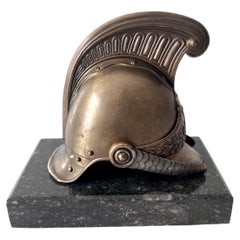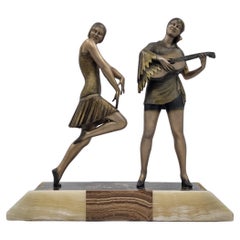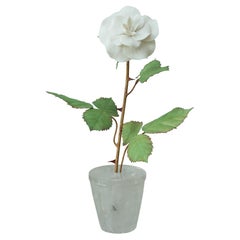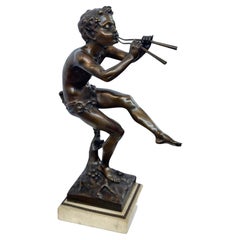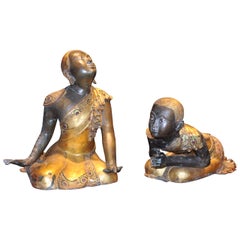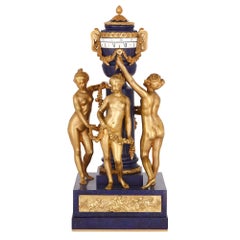Metal Figurative Sculptures
to
990
6,136
759
252
210
2,048
3,878
1,011
1,187
1,131
893
162
66
267
194
100
164
198
286
157
131
839
705
434
307
228
131
112
87
63
46
38
33
30
22
21
17
14
5
7,147
4,489
3,896
3,504
2,872
3,411
3,040
4,768
2,313
948
908
750
Height
to
Width
to
7,147
6,616
6,860
105
62
48
46
40
Material: Metal
Helmet Paperweight Mounted on a Piece of Marble Paris France
Located in Los Angeles, CA
Acquired in Paris France, this is a wonderful paperweight. A Helmut mounted on a piece of marble - a compliment to any desk or work station. The helmet is metal and the sides move a bit, as they are supposed to. A great curiosity, wonderful for a housewarming or fathers day gift.
Category
20th Century French Mid-Century Modern Metal Figurative Sculptures
Materials
Marble, Metal, Brass
Art Deco Sculpture Dancer and Musician
Located in Hoddesdon, GB
Exquisitely stylish Art Deco Figure portraying two young ladies in a musical and dancing theme, dressed in original Art Deco period costumes. Crafted from cold painted spelter, elegantly mounted on a multi-coloured marble...
Category
1920s French Art Deco Vintage Metal Figurative Sculptures
Materials
Onyx, Marble, Spelter
Samuel Mazy Biscuit Porcelain Rose Bush Sculpture in Rock Crystal Pot
By Samuel Mazy
Located in Toronto, ON
Enhance your table with these delicate porcelain flowers by French artist Samuel Mazy. This Rose Bush is handmade in biscuit porcelain with painted copper leaves...
Category
2010s French Metal Figurative Sculptures
Materials
Rock Crystal, Copper
Bronze Sculpture of a Mythical Faun by Clodion
Located in Los Angeles, CA
Mesmerizing bronze sculpture from the late 19th century of a mythical faun creature playing a flute by Claude Michel Clodion. This character gracefully rests on an elegant marble pl...
Category
Late 19th Century French Antique Metal Figurative Sculptures
Materials
Marble, Bronze
Pair of Patinated Gilt Bronze Buddhist Apostles
Located in Chicago, IL
These marvelously fluid and artistic figures were cast from bronze in the style of Northern Thailand and Burma. According to Buddhist tradition, the Buddha had two first Chief Disciples, Sāriputta and Moggallāna. They were wealthy young men seeking after higher knowledge and enlightenment and always depicted in elegant robes and often with unshaven heads. Depictions of these greatly -revered apostles are often found along side Buddha statues and holy angels...
Category
21st Century and Contemporary Thai Metal Figurative Sculptures
Materials
Bronze
$9,800 Sale Price / set
69% Off
Antique French Gilt Bronze and Lapis Lazuli Mantel Clock after Falconet
Located in London, GB
French sculptor Etienne-Maurice Falconet (1716-1791) is the inspiration for this beautiful, sumptuous mantel clock. His clock, crafted in the late 18th Century and now on display at the Louvre Museum, caused such a stir when it was exhibited over 100 years later, at the Great Exhibition in Paris in 1900 that one reviewer claimed that it "attracted so much admiration from the crowds gathered around that the pressure was sufficient at times to endanger its safety."
As well as this famed 'Three Graces...
Category
19th Century French Louis XVI Antique Metal Figurative Sculptures
Materials
Lapis Lazuli, Ormolu, Bronze
Large Antique Bronze Buddha 24 Carat Gold 19th Century Thailand
Located in Poperinge, BE
Fantastic authentic and antique bronze Buddha from Thailand from the Rattanakosin period, a large specimen gilded with 24 carat gold leaf, circa mid-19th century, this is the Dhyana ...
Category
Mid-19th Century Thai Antique Metal Figurative Sculptures
Materials
Bronze, Gold Leaf
Charles Massé, Gilt bronze Sculpture, Naked lady
Located in Encino, CA
Charles Massé (1855-1913)
Gilt bronze sculpture depicting a naked lady, on a brown marble pedestal
Art Nouveau period.
Category
Early 20th Century French Art Nouveau Metal Figurative Sculptures
Materials
Bronze
Monumental Important Art Deco Silver & Gilt Bronze Goddess G. Lavaroff
Located in New York City, NY
An exceptionally large and rare French Art Deco original bronze sculpture circa 1927 by a well known artist Georges Lavaroff (1895-1991)
It's quite uncommon to find this very large size and notably featuring the silver and parcel gilt finish.
The artwork features a majestic female nude, adorned with a stylized cloak in alternating stripes of gold and silver, which showcases a pyramid shape. The Egyptian goddess is depicted as an undraped figure with arms outstretched above her head, holding a crescent moon. She wears a north star headdress that adds to her regal appearance. The cloak is embellished with stars and a comet, and the female figure rests on a bed of stylized clouds. The sculpture is presented on its original black and gold marble base.
All of these attributes add to the uniqueness and value of the artwork, making it even more remarkable and sought after by collectors and art enthusiasts.
Water bottle shown for scale.
Documentation :
Les bronzes Art Deco de Georges Lavaroff, sculpteur Russe a Paris 1930
Kastelyn et Mazzucotelli.
Georges Lavaroff was born in Sibera in 1895. He studied medicine and painting. After the revolution of 1917 he moved to Moscow and became a member of the Russian artists association where he began to exhibit his work and take part in shows as a member of the Association of artists of Revolutionary Russia.
He then worked in France from 1927 until 1935. This period was the richest point of his profession where he produced his most famous works of Art Deco figures...
Category
Early 20th Century French Art Deco Metal Figurative Sculptures
Materials
Gold Plate, Silver Plate, Bronze
Large French 19th Century Patinated Bronze Sculpture of Salammbô by Marcel Début
By Marcel Debut
Located in London, GB
A Large Figural Bronze Sculpture of Salammbô
By Marcel Début
The patinated figure representing the character from Gustave Flaubert's titular novel Salammbô, as evidenced by the cart...
Category
Early 20th Century French Metal Figurative Sculptures
Materials
Bronze
Sophocles, Large Bronze Sculpture, 19th Century
Located in MARSEILLE, FR
Large bronze sculpture with a brown patina, representing the Greek playwright Sophocles: he is seated, holding a lyre in his right hand, next to...
Category
19th Century French Napoleon III Antique Metal Figurative Sculptures
Materials
Marble, Bronze
French Art Deco Bookends Young Satyrs by C. Charles on Marble Base, 1930
By C. Charles
Located in Buenos Aires, Olivos
French Art Deco bookends Young Satyrs by C. Charles on marble base, 1930
Lovely pair of Art Deco bookends with lying young satyrs by the French artist C. Charles. These wonderful, pl...
Category
1930s French Art Deco Vintage Metal Figurative Sculptures
Materials
Spelter
Discobolus Discus Thrower Classic Bronze Sculpture
Located in Red Lion, PA
This early 20th-century bronze sculpture is a finely crafted reduction of The Discobolus by Myron, one of the most celebrated sculptures of classical antiquity. Measuring approximate...
Category
20th Century Classical Greek Metal Figurative Sculptures
Materials
Bronze
Late 20th Century Vintage Boho Original Torch Cut Steel Figurative Sculpture
Located in West Palm Beach, FL
Make a bold statement with this striking vintage torch-cut steel figurative sculpture, a one-of-a-kind expression of raw artistry and industrial elegance. Standing an impressive 71 i...
Category
Late 20th Century American Brutalist Metal Figurative Sculptures
Materials
Steel
1980 Italy Bronze Abstract Sculpture Pietro Perin Figura Figure
Located in Brescia, IT
This artwork was created by the Italian artist Piero Perin.
Piero Perin was born in 1924, in Cervarese, near Padua Italy. He lived and worked in Padova where he teached at the School...
Category
Late 20th Century Italian Post-Modern Metal Figurative Sculptures
Materials
Bronze
“Tiny Brocade Jacket" by Gordon Chandler
Located in Chicago, IL
Upon discovering a weathered steel drum that had been warped to resemble the sleeve of a garment, artist Gordon Chandler was inspired to embark on a series of kimono sculptures forme...
Category
21st Century and Contemporary American Industrial Metal Figurative Sculptures
Materials
Steel
Late 19th Century Art Nouveau Bust Entitled "Lola" by Emmanuel Villanis
Located in London, GB
Stunning Art Nouveau bronze bust depicting the character "Lola" modelled in the midst of an inquisitive look. The study has a multi hued patination of colours that accentuate the very fine hand chased surface detail. Signed ?E Villanis...
Category
19th Century French Art Nouveau Antique Metal Figurative Sculptures
Materials
Bronze
Modern Still Life Bronze Sculpture 'Manzanas y Naranjas' by Rafael Muyor
Located in West Palm Beach, FL
Rafael Muyor Spanish, Madrid, born 1943
Bronze Sculpture ‘Manzanas y Naranjas’ (Apples and Oranges )
Signed on the center bottom.
A beautiful bronze sculpture of ‘Manzanas y Naranj...
Category
20th Century Spanish Modern Metal Figurative Sculptures
Materials
Bronze
$1,996 Sale Price
20% Off
Pair of Six-Foot High Topiary Spiral Shaped Cedar Plants
Located in Chicago, IL
Pair of Six-Foot High Topiary Spiral Shaped Cedar Plants with painted wood planters. We have used these and similar Topiaries in our showrooms for decades and there are currently 2-p...
Category
Early 2000s Chinese Metal Figurative Sculptures
Materials
Other
Pierre Schoenewerk "Erato" Patinated Bronze
Located in Astoria, NY
Pierre Alexandre Schoenewerk (French, 1820-1885) "Erato" Patinated and Gilt Bronze Sculpture, late 19th century, the seated muse with turtle-form lyre, on an oval base, signed, and c...
Category
Late 19th Century French Neoclassical Antique Metal Figurative Sculptures
Materials
Marble, Bronze
Vintage 1950s Handmade Robot Ashtray Sculpture Metal Scrap Art Articulating
Located in Hamilton, Ontario
Vintage One of a kind 1950s handmade metal Robot ashtray with articulating arms, pullout drawer and ash tray that comes out to be cleaned. On a hard plasti...
Category
1950s Canadian Mid-Century Modern Vintage Metal Figurative Sculptures
Materials
Metal
Israeli Modern Brass Sculpture of Lovers, Itzik Benshalom
Located in Queens, NY
Israeli Modern Brass Sculpture of Lovers, Itzik Benshalom
Category
20th Century Israeli Modern Metal Figurative Sculptures
Materials
Brass
Life Size Orientalist Figurative Bronze Torchiere
Located in New York, US
Our extraordinary patinated bronze torchiere depicting a female slave comes from the firm of Lacarrière Frères & Delatours. Signed "Lacarrière Freres & Delatours", "Paris 1880". Fitted for electricity in the late nineteenth century, but currently in need of sockets and wiring. Provenance: Rochelle Sepenuk, New York, NY.
The firm of Auguste Lacarrière sent exhibits to the the first International Exhibition in London in 1851. At that time they seem to have occupied two Paris addresses, 9 rue St Elizabeth and 55 rue Meslay, as well as having another outlet in Limoges. They are recorded as showing "specimens of lustres, sconces, chandeliers, medallions, etc..". By the 1862 Exhibition they were only recorded at the Sainte Elizabeth address and showed, "appareils à gaz de fonte, de zinc et de bronze." Nevertheless, their exhibit was highly praised and the business, now called A. Lacarrière, Père et Fils...
Category
1880s French Antique Metal Figurative Sculptures
Materials
Bronze
: "Sphynx" - Patinated bronze sculpture - end of XIXth C.1870
Located in SAINT-OUEN-SUR-SEINE, FR
Alfred Pierre RICHARD (1844-1884, France) : "Sphynx
Romanticized egyptian female Sphinx ("Sphinge" in french)with a jar topped with the head of god Horus
Black fine belgium marble b...
Category
1870s French Egyptian Revival Antique Metal Figurative Sculptures
Materials
Belgian Black Marble, Bronze
Bull's Head
Located in Paris, FR
Bronze with black patina
Limited edition of 8
Signed and numbered 1/8 on the back
Monogram of the artist left side
Stamp of the founder on the back.
Category
21st Century and Contemporary French Art Deco Metal Figurative Sculptures
Materials
Bronze
$33,527
Sculpture "Psyche and Love" Signed by Jean Bulio
By Jean Bulio
Located in Paris, FR
Statue in bronze with medal patina "Psyche and Cupid" realized by Jean BULIO. It represents Psyche, recognizable by her butterfly wingst. Her chest is bare and she is holding an arro...
Category
1850s French Antique Metal Figurative Sculptures
Materials
Bronze
Robert St Croix Polychrome Bronze of a Jester Juggling on a Unicycle
Located in WEST PALM BEACH, FL
#194/195 bronze copyright 1999 Fine Art Sales Commemorative Edition.
Robert St. Croix’s career as an artist began in the early 1970’s in San Francisco, where he gained a reputation f...
Category
1990s American Metal Figurative Sculptures
Materials
Bronze
Edmont Moirignot Paris Sculpture Poseidon Neptun Trident Bronze
Located in Munich, DE
We admire a very expressive sculpture of the ancient god of all the seas, Poseidon, standing proud and confident on a wave, holding a trident in his right hand.
Edmont Moirignot (Pa...
Category
1950s French Mid-Century Modern Vintage Metal Figurative Sculptures
Materials
Bronze
An equestrian bronze of the Duke of Wellington by Edward Baily, 1844
Located in Lymington, Hampshire
This bronze statuette shows Arthur Wellesley, Duke of Wellington riding his warhorse Copenhagen. He is dressed in civilian clothes with the reins in one hand and his top hat in the ...
Category
1840s English Antique Metal Figurative Sculptures
Materials
Bronze
Modern Brutalist Metal and Ceramic Figure Sculpture Signed Viro
Located in Keego Harbor, MI
A modern brutalist metal and ceramic sculpture signed Viro. This piece is in very good condition. It measures 38 inches tall, 18 inches long, and 8.5 inches wide.
Category
20th Century Unknown Brutalist Metal Figurative Sculptures
Materials
Metal
Auguste Moreau Bronze Angel Putto, France, 1855-1919
Located in Rijssen, NL
Auguste Moreau bronze angel putto. Original bronze, circa 1890 by Louis Auguste Moreau, (France, 1855-1919)
Depiction of a female angel with w...
Category
1890s French Art Nouveau Antique Metal Figurative Sculptures
Materials
Bronze
A Museum quality bronze sculpture entitled Eternelle Lumiere By E. Drouot
Located in Dallas, TX
A Museum quality bronze sculpture by Edouard Drouot . ( French 1859-1945) entitled Eternelle Lumiere . The Rouge marble pedestal is 1...
Category
Mid-19th Century French Belle Époque Antique Metal Figurative Sculptures
Materials
Bronze
Antique Austrian Orientalist Cold-Painted Bronze Sculpture
Located in London, GB
Antique Austrian Orientalist cold-painted bronze sculpture
Austrian, Early 20th Century
Height 33cm, width 19cm, depth 11cm
Showcasing the elaborate cold-painting technique, this ...
Category
Early 20th Century Austrian Metal Figurative Sculptures
Materials
Bronze
Sculpture "Veil Dancer" by Pierre Le Fuagays
Located in Ciudad Autónoma Buenos Aires, C
"Veil Dancer" by Pierre Le Fuagays (1892-1962). Gilded bronze sculpture and marble base.
Bryan Catley (1978) "Art Deco and Other Figures" p. 199.
France, CIRCA 1920.
Category
1920s French Art Deco Vintage Metal Figurative Sculptures
Materials
Bronze
Pair of Vintage Golf Themed Bookends
Located in Chapel Hill, NC
Pair of vintage golf themed bookends, American. Golf balls & driver heads (one a Top Flite by Spaulding) in brass bookend stands.
4" w., 5 7/8" h., 5" d. ...
Category
2010s American Metal Figurative Sculptures
Materials
Brass
18th Century Italian Angel Wing and Putto on Calcite with Citrine Points
By Interi
Located in Dublin, Dalkey
Sculptural 18th century Italian hand-carved angel wing mounted on a calcite crystal cluster and adorned with citrine points and joined with an angel head or "Putto". A Putto is a che...
Category
18th Century Italian Rococo Antique Metal Figurative Sculptures
Materials
Quartz, Rock Crystal, Gold Leaf
New Chandelier Pendant Lamp in Bronze Featuring a Wine Leaves
Located in Miami, FL
Magnificent chandelier in solid casted brass. Extraordinary elaborate finishes. Rich hangings with handmade leaves. Surface either brass and patinated.
Category
2010s Spanish Modern Metal Figurative Sculptures
Materials
Bronze
$18,864 Sale Price
20% Off
Bronze Sculpture of a Dancing Faun
Located in Gloucestershire, GB
Classic and well-modelled sculpture of a dancing faun.
Category
20th Century British Metal Figurative Sculptures
Materials
Bronze
Signed Art Nouveau Patinated Spelter Lighted Sculpture of Loie Fuller or Lamp
Located in Hamilton, Ontario
This large and substantial well executed lighted sculpture is signed by an unknown artist, and copyrighted by Napoleon Alliot of France and dates to ap...
Category
Early 20th Century French Art Nouveau Metal Figurative Sculptures
Materials
Spelter
“Tiny Striped Jacket" by Gordon Chandler
Located in Chicago, IL
Upon discovering a weathered steel drum that had been warped to resemble the sleeve of a garment, artist Gordon Chandler was inspired to embark on a series of kimono sculptures forme...
Category
21st Century and Contemporary American Industrial Metal Figurative Sculptures
Materials
Steel
Large Jean-Baptiste Carpeaux 1872 bronze "Le genie de la Danse" france.
Located in Rio De Janeiro, RJ
Incredible rare and large bronze for JEAN-Baptiste CARPEAUX 1872 representing "Le GENIE de la Danse".
Category
1870s French Empire Antique Metal Figurative Sculptures
Materials
Bronze
Jiang Tie Feng Bronze Sculpture Moonlight Dance
Located in Keego Harbor, MI
This vibrant bronze sculpture titled ""Moonlight Dance"" by Jiang Tie Feng captures the joyous energy and graceful movements of four dancers. Dressed in traditional attire, the figur...
Category
20th Century Chinese Metal Figurative Sculptures
Materials
Bronze
Bronze Sculpture of Horse Drawn Chariot by Tommaso Campaiola
Located in London, GB
Bronze sculpture of horse drawn chariot by Tommaso Campaiola
Italian, early 20th century
Dimensions: Height 48cm, width 76cm, depth 53cm
This ex...
Category
Early 20th Century Italian Metal Figurative Sculptures
Materials
Bronze
Carl Auböck Monumental Lifesize Brass Foot Sculpture, Werkstätte Auböck, Austria
Located in Vienna, AT
We are offering this impressive 13“ long and 8“high brass foot sculpture, designed and manufactured by Werkstätte Carl Auböck, Vienna, Austria.
This charming and attention-grabbing ...
Category
21st Century and Contemporary Austrian Mid-Century Modern Metal Figurative Sculptures
Materials
Brass
Grand Tour Pair of Bronze Warriors on Sienna Marble Bases
Located in London, GB
Grand tour bronzes of fighting men set on Sienna marble bases of very good colour. The two warriors in full armour and looking like medieval or renaissance soldiers are in a fighting stance both carrying shields and one carrying a mace and the other a battle axe...
Category
1880s Antique Metal Figurative Sculptures
Materials
Siena Marble, Bronze
Jorge Blanco 'B1945' American, "Eclipse" Sculpture, 2011
Located in Sarasota, FL
Jorge Blanco 'b1945' American, "Eclipse" Sculpture 2011. Black abstract sculpture, titled "Eclipse". Signed and dated in the front lower right Jorge Blanco 2011. Aluminum and black p...
Category
2010s North American Modern Metal Figurative Sculptures
Materials
Aluminum
Spanish Warrior, Conquistador Standing with Sword and Decorative Shield
Located in Stamford, CT
This is a good looking Spanish Warrior or Conquistador holding a sword with a decorative shield. From a private collector who filled his home with beautiful and unique pieces over th...
Category
Late 20th Century Metal Figurative Sculptures
Materials
Metal
$760 Sale Price
20% Off
Snake Charmer, In The Style Of Preiss, Bronze, Art Deco, 20th Century
Located in MARSEILLE, FR
Charming patinated bronze centerpiece representing a young woman kneeling playing the flute in front of a snake.
The snake charmer and the snake are fixed on an onyx base
Sculpture ...
Category
Early 20th Century European Art Deco Metal Figurative Sculptures
Materials
Onyx, Bronze
Late 19th Century Pair of Military Bronze Soldiers by Etienne Henri Dumaige
Located in Stamford, CT
Late 19th century pair of bronze French soldiers by Etienne Henri Dumaige. Representing two separate moments in the French Revolution, the uprisi...
Category
Late 19th Century French Antique Metal Figurative Sculptures
Materials
Bronze
Large, Decorative Bronze Sculpture of a Spartan Warrior with Sword, Greco Roman
Located in Berlin, DE
Large and decorative bronze sculpture of a Spartan warrior.
By Professor Victor Heinrich Seifert. Signed.
Excellent masterpiece. On marble base.
Category
19th Century Austrian Antique Metal Figurative Sculptures
Materials
Bronze
$8,142 Sale Price
20% Off
Bronze Sculpture of a Dancer - D.H.Chiparus - copy
Located in Praha, CZ
Bronze statue on marble base in art deco style. Copy of a dancer sculpture by D.H.Chiparus.
Category
Late 20th Century French Art Deco Metal Figurative Sculptures
Materials
Marble, Bronze
Antique Cast Metal French Greyhound Chenets
Located in Victoria, BC
Enhance your home with this lovely pair of antique French chenets (firedogs, andirons etc..). Crafted from cast metal, these fireplace accessories feature reclining greyhounds atop i...
Category
Late 19th Century French Antique Metal Figurative Sculptures
Materials
Metal
Antique Pair of 1920's Art Deco German Moch Mannequins
By Moch Figuren
Located in London, GB
Antique Mannequins, Vintage Mannequins, 1920's Mannequins, Art Deco Antiques, German Youth Mannequins, German Cabaret Mannequins, Antique Artist Lay Figures.
Antique Pair of 1920s A...
Category
1920s German Art Deco Vintage Metal Figurative Sculptures
Materials
Metal
Italian Grand Tour Bronze of The Apollo Belvedere
Located in Wormelow, Herefordshire
An antique Italian Grand Tour bronze sculpture of ‘The Apollo Belvedere’ circa 1890, after the antique. Sourced from an ex. private UK collection.
Dating from the late 19th century,...
Category
Late 19th Century Italian Neoclassical Antique Metal Figurative Sculptures
Materials
Metal, Bronze
Life-Size Bronze Greek Discus Olympian Statue, 20th Century
Located in Southall, GB
A 20th century life-size, strong, bronze figure of a Greek Olympian throwing the discus during his spin. This large bronze stands over 5.5 feet tall. The quality is exceptional, with...
Category
20th Century European Classical Greek Metal Figurative Sculptures
Materials
Bronze
$8,279 Sale Price
20% Off
Emil Filla "Maternity" Bronze Sculpture
Located in Naples, IT
Bronze sculpture "Maternity Woman" by Emil Filla, cubist sculptor.
Category
Early 20th Century Czech Mid-Century Modern Metal Figurative Sculptures
Materials
Bronze
Spectacular Patinated Bronze SCULPTURE "The Child and the Crab" 19th Cent. VIDEO
Located in Madrid, ES
Spectacular Patinated Bronze SCULPTURE depicting "The Child and the Crab"19th century
Italy late 19th century
100 x 70cm
good conditions
Category
19th Century Italian Renaissance Antique Metal Figurative Sculptures
Materials
Bronze
$2,777 Sale Price
20% Off
Janle / Max Le Verrier, Paire De Serre-livres Don Quichotte, Art Déco, XXème Siè
By Janle
Located in MARSEILLE, FR
Pair of bookends representing the hero of Spanish literature Don Quixote and his faithful Sancho Panza: both are seated, asleep.
Metal sculptures with a brown patina (spelter), o...
Category
Early 20th Century French Art Deco Metal Figurative Sculptures
Materials
Spelter
Orientalist Cold Painted Vienna Bronze, Bergman Foundry, Young Children on Rug
Located in Petaluma, CA
We buy many Vienna bronzes by the Bergman foundry. They do capture our imagination. We can safely say that this one is most unusual and whimsical. It's not the children that is part...
Category
1910s Austrian Other Vintage Metal Figurative Sculptures
Materials
Bronze
"Pleasure of the Courtesan"Bronze Sculpture by Erté, '1988'
By Erté
Located in Los Angeles, CA
Limited edition "Pleasure of the Courtesan" sculpture by Erté made with cold-painted and gilt bronze depicting a beautiful woman with a chain surroun...
Category
1980s French Vintage Metal Figurative Sculptures
Materials
Bronze
